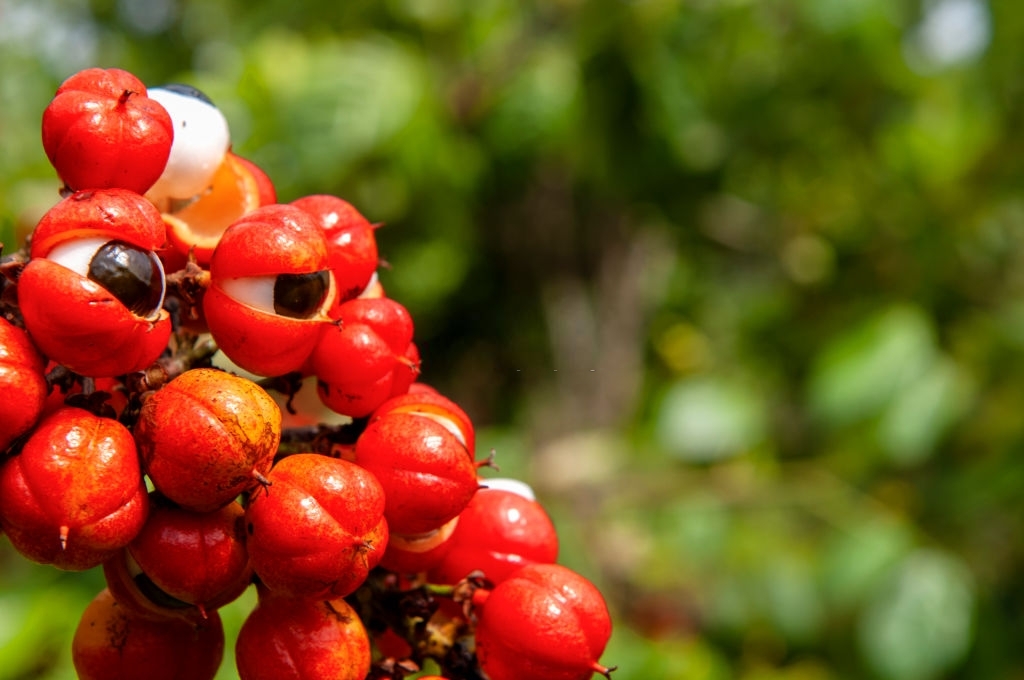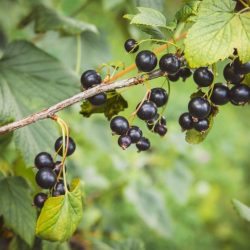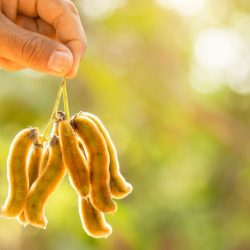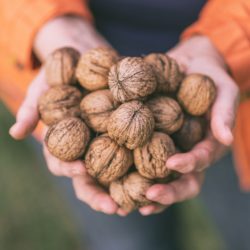Guarana is native to the lower Amazon, Brazil to be precise, where it grows in abundance. Cultivated in a few places on the South American continent, this plant has only been known in Europe since 1817. Guarana is a Brazilian name derived from the name of the Guarani tribe, indigenous to Amazonia.
What is guarana?
The genus Paullinia, which includes nearly 180 species, is famous for its traditional use by Amerindians, particularly 40 species. Among them, Paullinia CupanaH.B.K. var. sorbilis, from the Sapindaceae family, is a woody vine growing up to 15 metres. It is characterised by stems 4 to 8 mm in diameter, with tendrils and deep furrows. The plant has alternate, compound, imparipinnate leaves 20 to 40 cm long with 5 leaflets. Its unisexual, white, zygomorphic flowers form axillary inflorescences.
The fruits are ellipsoidal capsules 2 to 3 cm long, usually containing three ovoid seeds without albumen, surrounded by a whitish aril. When ripe, the fruit resembles an eye, which is how it fits in with Amerindian legends. Guarana grows in areas where temperatures vary between 21 and 26.5°C, with annual rainfall of around 250 mm and relative humidity of 80% to 86%. Native to the Amazon basin, it is mainly grown in the lower Amazon, especially in the state of Amazonas.
In terms of chemical composition, guarana seeds are particularly rich in fibre and methylxanthines, especially caffeine. The concentration of caffeine is extremely high, at around 4 g’100g-1, four times higher than in coffee beans. Caffeine permeates the entire plant, including the leaves. Theophylline and theobromine are also present in lesser quantities.
Finally, guarana contains around 5g 100g-1 of tannins and saponins, which influence its stimulant activity. When consumed as a powder, the seed is used for its stimulant properties. Guarana is also an industrial source of caffeine and crucial plant material for studying caffeine biosynthesis.
A little history
The Guaranis attribute divine origins to this plant, the first of which is said to have come not from a seed but from the eyes of a divine child killed by a snake. This may have something to do with the fact that the tree was deified. The divinity would have wanted to perpetuate the destroyed life force for the benefit of mankind. Long before European botanists studied the plant, guarana was a drink that the Manes tribe prepared in secret. It was from this beverage that they drew their strength and longevity, continuing to attribute divine origins and powers to it.
The Amerindians were the first to discover the medicinal effects of guarana, which was already being used in pre-Columbian times.
The seeds are lightly roasted and fermented. In Amazonia, the paste has been prepared since ancient times by crushing the almonds with water. It is presented in the form of sticks or turtles, a symbol of resistance. After shaping, these shapes are dried in the sun or in the oven before being eaten. In this region of Brazil, the paste is used to make refreshing and invigorating drinks.
Traditionally, a stick of guarana is grated into a calabash using the dried tongue of a giant fish, the pirarucu, which inhabits the Amazon basin. This is done every morning to obtain the equivalent of one teaspoon of guarana powder, to which enough water is added. After ensuring that all the powder has been properly dissolved, the drink is taken on an empty stomach.
At the beginning of the 18th century, the German doctor Christian-François Paullini discovered the plant and gave it its scientific name. Europe developed its use at the end of the 19th century. Guarana was then included in the Pharmacopoeia and recognised for its stimulating properties.
Medical literature and clinical trials
- Fisone G. et al, Caffeine as a psychomotor stimulant; mechanism of action, Cell Mol Life Sci, 2004
- Walsh D.A. et al, Multiple pathway signal transduction by the cAMP-dependent protein kinase, Faseb J., 1994
- Huang Z.L. et al, The role of adenosine in the regulation of sleep, Curr Top Med Chem, 2011
- Cauli O. et al, Caffeine and the dopaminergic system, Behav Pharmacol, 2005
- Haskell C.F. et al, A double-blind, placebo-controlled, multidose evaluation of the acute behavioural effects of guarana in humans; J Psychopharmacol, 2007
- De Oliveira Campos M.P. et al, Guarana (Paullinia cupana) improves fatigue in breast cancer patients undergoing systemic chemotherapy; J Altern Complement Med, 2011
- Belza A. et al, The effect of caffeine, green tea and tyrosine on thermogenesis and energy intake; Eur J Clin Nutr, 2009
- De Oliveira D.M. et al, Paullinia cupana Mart. var. Sorbilis protects human dopaminergic neuroblastoma SH-SY5Y cell line against rotenone-induced cytotoxicity, Hum Exp Toxicol, 2011
- De Waele S., Van Belle S., Cancer-related fatigue, Acta Clin Belg, 2010
- Costa Krewer Car. et al, Habitual Intake of Guarana and Metabolic Morbidities; An Epidemiological Study of an Elderly Amazonian Population, Phytother Res, 2011
- Leite R.P. et al, Protective effect of Guarana (Paullinia cupana var. sorbilis) pre-treatment on cadmium-induced damages in adult Wistar testis; Biol Trace Elem Res, 2011
- Mara T. et al, Chemical and Microbiological Study of Extract from Seeds of Guarana (Paullinia cupana var. sorbilis), Lat. Am. J. Pharm, 2007
- Boasquivis P.F. et al. Guarana (Paullinia cupana); Extract Protects Caenorhabditis elegans Models for Alzheimer Disease and Huntington Disease through Activation of Antioxidant and Protein Degradation Pathways; Oxid Med Cell Longev, 2018





